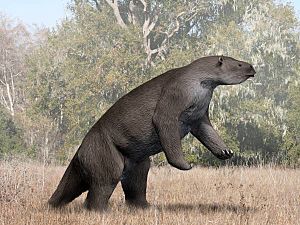Megatherium facts for kids
Quick facts for kids Megatherium |
|
|---|---|
 |
|
| Skeleton of Megatherium americanum in the Natural History Museum, London | |
| Scientific classification | |
| Kingdom: | |
| Phylum: | |
| Class: | |
| Superorder: | |
| Order: | |
| Family: |
†Megatheriidae
|
| Genus: |
†Megatherium
Cuvier, 1796
|
Megatherium was a giant, slow-moving mammal. It lived during the Ice Age (the Pleistocene epoch) in South America. This huge animal went extinct about 11,000 years ago. Megatherium was the biggest of all ground sloths. Its name means "great beast." The first fossil of Megatherium was found in Brazil in 1789. Later, in 1856, paleontologist Richard Owen officially named it.
Contents
How Megatherium Evolved
Ground sloths are part of a group called Xenarthra. This group started in South America. It includes other extinct animals like glyptodonts (which looked like giant armadillos). It also includes living animals such as sloths, armadillos, and anteaters.
For a long time, xenarthrans, including ground sloths, developed only in South America. This was when South America was an island continent.
Then, during the Pliocene epoch, a land bridge formed. This bridge connected North and South America. It's called the Central American Isthmus. This event led to the Great American Interchange. Many animals moved between the continents. Some South American animals, like ground sloths, moved north. They lived and thrived in North America until the end of the Ice Age.
Scientists think that a rhinoceros-sized animal called Promegatherium was an ancestor of Megatherium. The oldest and smallest Megatherium species, M. altiplanicum, lived in Bolivia. It was also about the size of a rhinoceros. Over time, Megatherium species grew larger. The biggest species, M. americanum, was as large as a modern African elephant.
What Megatherium Looked Like
Megatherium was one of the largest land mammals ever known. It could weigh up to 4 tons (about 4,000 kg). From head to tail, it measured up to 6 meters (20 feet) long. It was the biggest ground sloth, as large as modern elephants. Only a few types of mammoths were bigger during its time. The most famous species is M. americanum. Megatherium was part of the Pleistocene megafauna. These were the very large mammals that lived during the Ice Age.
Megatherium had a strong skeleton with a big hip area and a wide, muscular tail. Its huge size helped it reach food that other plant-eaters couldn't. It could stand on its powerful back legs. It used its tail like a third leg, forming a tripod for balance. This allowed it to support its heavy body. Then, it used the curved claws on its long front legs to pull down branches with tasty leaves.
Like a modern anteater, this sloth walked on the sides of its feet. Its long claws stopped it from putting its feet flat on the ground. Even though it usually walked on all four legs (a quadruped), its footprints show it could also walk on two legs (a biped). Scientists believe its body was built to allow it to stand upright.
Megatherium had a narrow, cone-shaped mouth. It likely had strong, flexible lips to pick specific plants and fruits. It was very good at eating tough plants. Its narrow snout suggests it was a picky eater. It could choose exactly which leaves and twigs it wanted to eat.
Where Megatherium Lived
Megatherium lived in woodlands and grasslands in South America. It was a native species there. The last ones lived about 10,000 years ago. Megatherium preferred open areas that were dry or semi-dry, with some trees. For example, some of the most recent finds are at Cueva del Milodón Natural Monument in Patagonian Chile. A close relative, Eremotherium, lived in warmer, more tropical places further north. It even moved into North America during the Great American Interchange.
How Megatherium Lived
The giant ground sloth probably lived in groups, but some might have lived alone in caves. It mainly ate plants, like leaves, yuccas, agaves, and grasses. It would stand on its hind legs, using its tail for balance, to reach high branches. It would pull plants with its feet, digging them up with its five sharp claws. The sloth used its simple teeth to grind food. Its strong cheek muscles helped with this. Its stomach could digest tough, fibrous plants. It probably spent a lot of time resting to help its food digest.
Some studies suggest that Megatherium was good at biting vertically, up and down. Its teeth were sharp and triangular, good for cutting rather than grinding. This means it might not have eaten only very hard, fibrous plants.
There's a debate about whether the giant sloth might have eaten meat sometimes. Some scientists think Megatherium could have used its claws like daggers. They suggest it might have stolen kills from other predators, like Smilodon (saber-toothed cats). It's also been suggested that Megatherium could have flipped over large, armored animals like glyptodonts to eat them. However, other scientists disagree. They point out that sloths don't have the special teeth that meat-eaters have. Also, no bone fragments have been found in the many fossilized sloth droppings. So, this idea is still very much a topic of discussion among scientists.
Why Megatherium Disappeared
In the south, the giant ground sloth lived well until about 10,500 years ago. Most scientists believe that the growing number of human hunters caused its extinction. There are a few later dates for Megatherium remains, but the most reliable date is around 10,000 years ago. Studies also show that the areas where Megatherium could live shrank and became separated. While this alone might not have caused its extinction, it likely played a part.
Images for kids
-
This skeleton of M. americanum in the Museo Nacional de Ciencias Naturales, Madrid, was the first prehistoric animal skeleton ever put together, in 1795.
See also
 In Spanish: Megaterios para niños
In Spanish: Megaterios para niños







